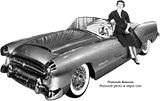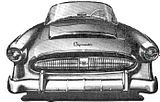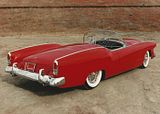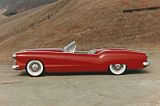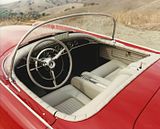| The Belmont made its public debut at the Chicago Auto Show and no doubt caused more than a few hearts to skip a beat. Resplendent in Azure Blue, the topless, V-8-powered, fiberglass-bodied model gave a glimmer of hope to Plymouth dealers-some predicted this would be Plymouth's answer to the Corvette and Thunderbird.
Although officially tagged a Plymouth, Chrysler described the Belmont as a "styling experiment on a 1954 Dodge chassis." It was designed and built by Briggs Body (soon to be purchased by Chrysler). While Plymouth and the small Dodge shared the same 114 inch wheelbase chassis, only Dodge offered a V-8, Plymouth's first V-8 wasn't scheduled to appear until 1955 in a model coded the P27 series. Although credited to Dodge, the V-8 in the Belmont carries serial number P27-1014-the fourteenth Plymouth V-8 built! Why this fact was never made public is a secret remaining with Chrysler. With an overall length of 191-1/2in, the Belmont was not a small car. Overall width was slightly more than 73in with a height of 49.3in. Among the car's unusual features was a radio with power antennae controls located in the center armrest, a removable cloth top, and a spare tire carried in a separate behind-seat compartment. The Belmont's styling was clean, but soon became dated. Motor Trend pictured the car in its May 1954 issue but one year later discounted rumors Plymouth would build it as the design was "too old to consider for production." The Belmont managed to escape the crusher and surfaced in Oregon in 1988. Its owner, Don Heckler, had purchased it in 1968 when the previous owner had tired of all the attention the Belmont drew whenever it was driven. Little is known of the car's early history once it departed Chrysler. It did make a dealer tour in Southern California and appeared in the 1956 movie Bundle of Joy starring Eddie Fisher and Debbie Reynolds; it. is also thought to have been used in the 1957 movie Mister Cory starring Tony Curtis. The restored (but incorrectly painted red) Belmont now resides in the Blackhawk Collection in California and is on display with other Chrysler dream cars of the era. [It is now in the hands of Don Williams in New Jersey.] by Jim Benjaminson Originally printed by Motorbooks International. |
In it's original light metallic blue paint |
Plymouth’s plastic fantastic: 1954 Belmont concept car to cross the blockKurt Ernst Aug 29th, 2013 Could Plymouth have benefited from a challenger to the Chevrolet Corvette and Ford Thunderbird in the two-seat sporting car field? Automotive historians could debate that question ad nauseam, but we at least know what such a car might have looked like: the 1954 Plymouth Belmont concept car that will cross the block at the upcoming Barrett-Jackson auction in Scottsdale, Arizona, next January. By the start of 1954, Plymouth’s sales had fallen to a fraction of rates once considered normal. In an effort to shore up Plymouth’s performance and build some excitement around the brand, Chrysler’s chief of styling, Virgil Exner, led his department in producing a pair of concepts for the 1954 show season, the other one being the six-cylinder-powered Ghia-built Plymouth Explorer Coupe. The Belmont, built for Chrysler by Briggs Manufacturing Company on a Plymouth 114-inch wheelbase chassis, boasted a couple of firsts for the struggling Chrysler division. It was the first Plymouth to carry a body constructed of fiberglass instead of steel, and it was the first Plymouth fitted with a V-8 engine. The provenance of that engine seems to have caused some confusion over the years: Plymouth didn’t offer its 157hp poly-head 241-cu.in. V-8 in production cars until 1955, so when it introduced the Belmont, Chrysler claimed that a 150hp Dodge Red Ram Hemi V-8, available in production form in 1954 and also measuring in at 241 cubic inches, powered the Belmont. Not so, said Don Williams, who owned the Belmont during the 1990s; he said it has always had a poly-head 241, the same engine that powers it today. Indeed, Allpar notes that the engine’s serial number is P27-1014, which identifies it as the 14th Plymouth V-8 built for the 1955 model run. Backed with a Hy-Drive semi-automatic transmission and stretching out long (nearly 192 inches from tip to tail) and low (maximum height of just 49 inches), the Belmont debuted at the 1954 Chicago Auto Show in a metallic light blue and exhibited what Exner and his team believed to be an aerodynamic design theme. Unlike later “show only” concept cars, the Belmont was a functional automobile, as long as driver and passenger were willing to make a few concessions to style. Its windshield, for example, was formed from thick plexiglass, meaning the view ahead was somewhat distorted, especially through the curved portions. It’s unclear how much effort was put into the weather-sealing of the top, as the car was never intended to be driven for any distance in the rain. The car lacked exterior door handles, too, meaning that driver and passenger had to reach inside the car to open the doors, though this would likely have been addressed had the car gone into production. Following its appearance on the 1954 auto show circuit (and its film debut in the 1954 motion picture Bundle of Joy, starring Eddie Fisher and Debbie Reynolds), the Belmont was retired as “too old” a design to fit the company’s image. At this stage, most concepts either get locked in corporate vaults or stripped of usable parts before being shipped to the crusher, but Exner had an attachment to the Belmont the Belmont survived as a road car, passing through a string of owners over the years Early in the car’s development, the stylist struck a deal with Chrysler, giving him clear ownership of the convertible once it was retired from the show circuit (a feat no longer possible, as today’s pre-production models can’t be registered by individuals). Exner and his family owned the Belmont until The Belmont’s ownership is unclear until 1968, when it was sold to Marie DeAngelo. From there, it was sold to Don Heckler in 1970 and remained in his possession until 1989. Unearthed by Loren Tyron in 1989, the car was purchased for Williams as part of the Blackhawk Collection and underwent a complete restoration (during which Williams had the car sprayed red instead of its original blue). In 2001 Williams sold it at the Barrett-Jackson Scottsdale auction to Ele Chesney in New Jersey, and from there the ownership history is lost, though when it came up for sale on Hemmings.com in 2010, a dealership on Long Island advertised it. As part of Barrett-Jackson’s Salon Collection, the Belmont is expected to cross the block with a reserve. Barrett-Jackson’s Scottsdale auction is scheduled for January 12-19, 2014. |
|
Who really designed the 1954 Plymouth Belmont?Daniel Strohl Aug 30th, 2013 In the recent article on the 1954 Plymouth Belmont concept car, many people expressed doubt that Virgil Exner actually penned the Belmont’s lines, despite the fact that Exner had taken credit for the car for many years. Indeed, it would be a stretch to say that the Belmont uses any of Exner’s love-it-or-hate-it design language, but that’s the way design studios worked at that time – the head of the studio would more often than not take credit for the work that the designers who worked under him produced, no matter how many brushstrokes he applied to the work. Still, the truth eventually makes its way out, and we have reader Dave Langstone and author Peter Grist to thank for setting the record straight here. Grist, author of Virgil Exner, Visioneer, pointed out in his 2007 biography of the designer that Bill Robinson, a designer with Briggs Manufacturing, actually designed the Belmont and that he later let Exner take credit for the design. Langstone pointed that out to us too, and took it a step further, not only by providing photos of Robinson’s sketches for the Belmont, which he donated to the Walter P. Chrysler Museum last year, but also by putting us in touch with Robinson. Robinson said that Chrysler’s K.T. Keller did indeed want a Corvette competitor and that he instructed Al Prance at Briggs to begin work on one. Prance turned to Robinson, who had been with Briggs as a designer for about five years at that time. “At first, I was thinking they wanted a real concept car, so I had drawings with fins and that nature,” Robinson said. “But as the project progressed, I figured that they were looking more for a true sports car than a concept car, so I grew more conservative in my designs.” According to Robinson, he wasn’t much of a fan of sports cars at the time, so he didn’t take inspiration from any particular car. In addition, he had a few design limitations around using production pieces – specifically the chassis and bumpers – so he said he instead wanted to experiment with new forms and shapes in his design. “I was most concerned with getting rid of the outboard headlamps,” he said. “The body shapes trail off from outboard headlamps, so I figured that if I moved them inboard, I could try out different side contours.” That effort shows in at least a few of the design sketches that Robinson provided to the museum, in particular the two-tone copper-over-gold sketch and the pair of sketches with the iridescent blue paint that rather closely matches the color the Belmont originally wore. Of course, a number of changes took place between sketch and final product. “Any time you see a concept drawing that looks just like the real-life car, you know it’s a fraud and was done after the fact,” Robinson said. The most significant change that took place was, of course, his superiors’ insistence that the headlamps be moved back to an outboard position, thus scrubbing most of the impact Robinson aimed for. Robinson said he also didn’t much like having to change his design to raise the hood a couple of inches for engine clearance. “The hood and the decklid had the same contour until then,” he said. “Fortunately, Walt Brocker, who worked with me on the full-size drawing, kept as much of the existing form as he could when he added the hoodscoop.” Sometime during or shortly after the completion of the Belmont, Chrysler purchased Briggs and Robinson transferred to Chrysler’s styling department. He said he wasn’t too pleased with the result (“Those gunsight headlamps were the only real way to make it distinctive.”), so when Exner approached him and asked to take credit for the Belmont, Robinson was more than happy to let him do so. “I felt good that Exner thought enough of it to want to take credit for it,” he said. Over the years, he remained silent on the issue because “I always felt the owner could get more for it as an Exner car than as a Robinson car.” Robinson stayed with Chrysler until 1980 and followed his career there by teaching automotive and transportation design at the Center for Creative Studies in Detroit.
|
|



